Physical Address
304 North Cardinal St.
Dorchester Center, MA 02124
Physical Address
304 North Cardinal St.
Dorchester Center, MA 02124
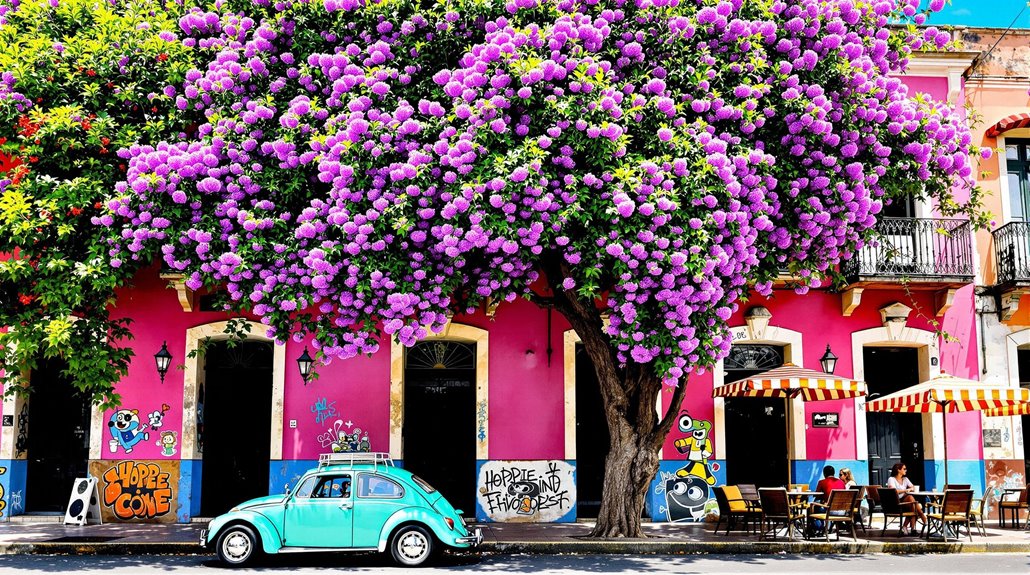
Mexico City’s coolest neighborhoods offer a perfect blend of history and hip culture. You’ll find Frida Kahlo’s legacy in Coyoacán’s Casa Azul, colonial mansions in San Ángel, and Art Nouveau architecture in Roma Norte. Discover underground art galleries in San Rafael, traditional markets in Santa María La Ribera, and hidden speakeasies in Juárez. Each district showcases unique street art, local crafts, and affordable eats. These vibrant barrios hold countless secrets waiting to be uncovered.
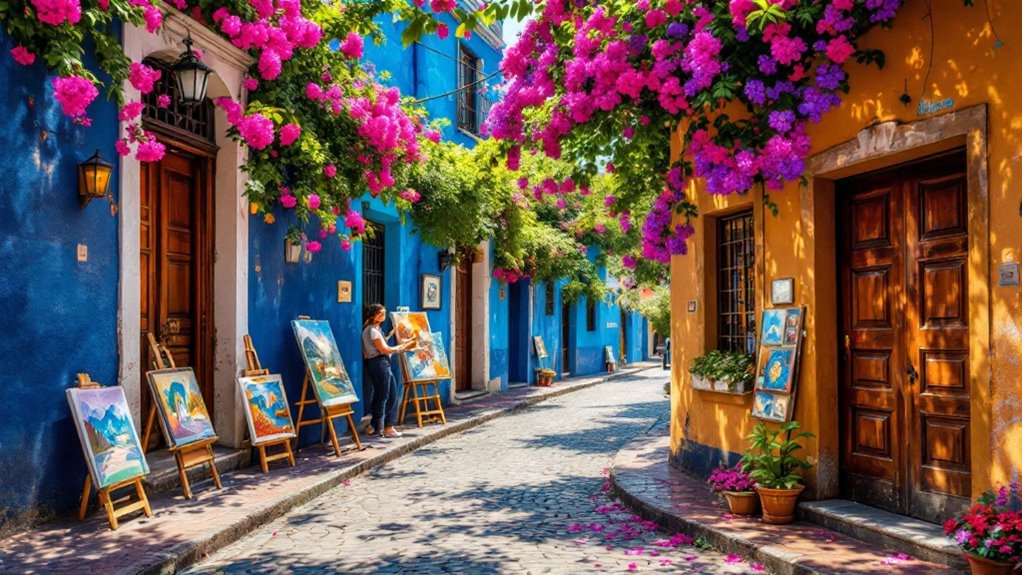
While many neighborhoods in Mexico City pulse with creative energy, Coyoacán stands apart as the artistic heart of the capital, largely due to its most famous resident, Frida Kahlo.
Her cobalt-blue Casa Azul, now the city’s second-most visited museum, offers a glimpse into her fascinating world through personal artifacts, diaries, and artwork.
Step inside Casa Azul, where Frida Kahlo’s personal treasures and vibrant art reveal the soul of Mexico’s most beloved artist.
You’ll find Coyoacán’s creative spirit alive in its UNESCO-recognized historic center, where cobblestone streets lead to Plaza Hidalgo‘s vibrant art scene. The neighborhood features beautiful old streets that transport visitors back in time.
The neighborhood boasts diverse cultural spaces, from the glass-walled Centro Cultural Elena Garro to the historic Estudios Churubusco film studios.
Don’t miss the traditional Mercado de Coyoacán, where local artisans preserve age-old crafting techniques like alebrijes and papel picado.
For budget-conscious travelers, many venues offer free exhibitions and workshops, making Coyoacán’s artistic heritage accessible to all.
Just south of Coyoacán’s artistic bustle, San Ángel offers an enchanting blend of colonial grandeur and creative energy.
You’ll find cobblestone streets lined with pastel-colored mansions, including the historic Casa del Mayorazgo de Fagoaga and the allegedly haunted Casa Blanca.
For art lovers on a budget, the Bazar del Sábado in Plaza San Jacinto is a must-visit. This weekly market showcases local crafts and live music, while the adjacent Jardín del Arte displays works by emerging artists.
Don’t miss the El Carmen complex, a 17th-century monastery turned museum where you can explore colonial artifacts and meet some unusual residents – mummified Carmelite monks. The monastery’s grounds once contained thriving orchards with over 13,000 trees that contributed to its wealth and prominence.
During spring, the neighborhood’s jacaranda trees burst into purple bloom, creating perfect photo opportunities against the backdrop of baroque balconies and tiled domes.
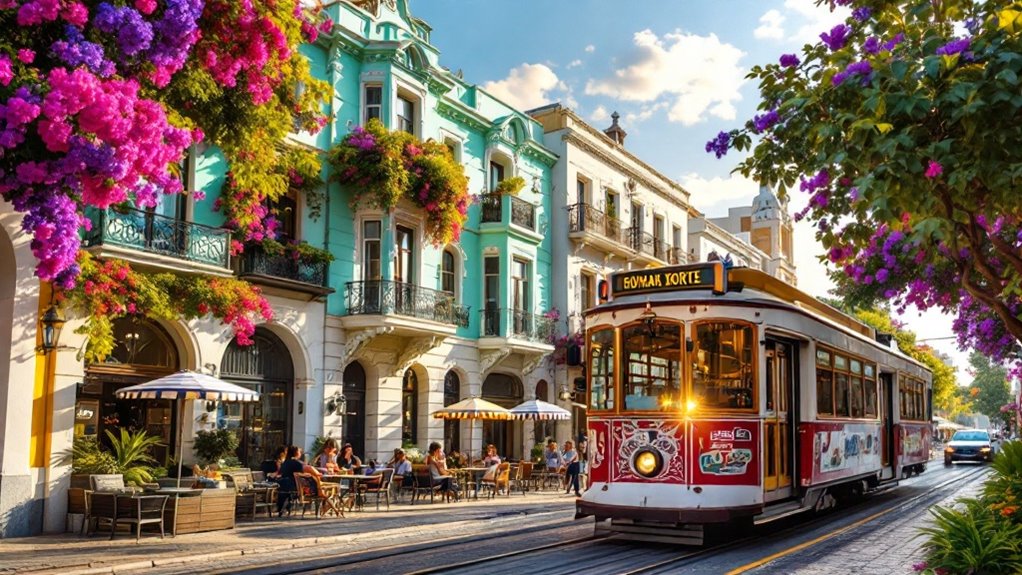
You’ll find Roma Norte’s grand Porfirian-era mansions and Art Nouveau buildings telling stories of Mexico City’s elegant past, from the Gothic-inspired Casa de las Brujas to the neoclassical Edificio Balmori.
While many of these architectural treasures were nearly lost to the 1985 earthquake, the neighborhood’s 1990s revival has transformed abandoned buildings into cultural spaces, with Casa Lamm’s art exhibitions leading the charge.
The area’s culinary scene has evolved from its upper-class roots to embrace an eclectic mix of local eateries and innovative restaurants along Álvaro Obregón Avenue, where you can experience high-end dining or grab affordable street food at Mercado Medellín. Today, visitors can explore the neighborhood safely while enjoying its bustling atmosphere, as it’s considered one of the safest districts in Mexico City.
As you stroll through Roma Norte‘s tree-lined boulevards, you’ll discover an architectural wonderland born from Mexico City’s ambitious 1902 expansion. The neighborhood showcases an impressive blend of Art Nouveau, Neoclassical, and Neo-Gothic styles, with over 70% of its original early 20th-century architecture still intact.
You can explore landmarks like the Gothic-inspired Casa de las Brujas with its distinctive pointed roofs, or admire the decorative façades of Edificio Balmori.
The area’s Porfiriato Art Deco mansions feature unique mixtilinear arches and grotesques, while the Neo-Gothic Parroquia de la Sagrada Familia dazzles with its ribbed vaults and stained glass windows.
The 1990s revitalization breathed new life into these historic structures, transforming abandoned mansions into cultural spaces like Casa Lamm, where you can experience art exhibitions in preserved French-inspired gardens. Founded by Eduardo Walter Orrin in 1872, the district stands as a testament to the city’s rich architectural heritage.
The culinary revolution sweeping through Roma Norte seamlessly blends historic traditions with modern innovation.
You’ll find neo-classical pastries studded with Mexican ingredients at Panaderia Rosetta, housed in a stunning Porfirian mansion, while Mercado Roma‘s three-story food hall offers everything from vegan carnitas to craft beers on its panoramic rooftop.
Street food gets a creative upgrade at spots like Gonzalitos, where northern-style flour tortilla tacos meet slow-cooked barbacoa, and El Compita’s Tijuana-inspired quesabirria draws crowds. The neighborhood’s bustling weekly tianguis markets showcase fresh local produce and artisanal street food vendors.
For fine dining, head to Maximo Bistrot, ranked among Latin America’s top 50 restaurants, or try Contramar’s legendary tuna tostadas.
Don’t miss Chef Elena Reygadas‘ award-winning creations at Rosetta, where traditional Mexican baking meets French technique in a colonial setting.
You’ll discover San Rafael’s thriving underground art scene centered around the historic Museo Experimental el Eco, where Mathias Goeritz’s “Emotional Architecture” concept still influences contemporary experimental works.
The neighborhood’s transformation from a Porfirian-era aristocratic enclave to an affordable artistic hub has attracted emerging collectives and budget-conscious creators to its network of repurposed spaces, including Casa Maauad’s artist residency and the converted Galeria SQ73. Espectro Electromagnetico and Taller Luum have also established themselves as key venues shaping the area’s creative identity.
Weekly art markets at Jardín del Arte Sullivan offer pieces ranging from 300 to 50,000 MXN, making the area’s creative output accessible to both casual browsers and serious collectors.
Stepping into San Rafael’s experimental art scene feels like discovering a secret creative revolution. In this neighborhood, galleries have ingeniously repurposed unexpected spaces, transforming them into dynamic venues for contemporary art.
You’ll find Yautepec gallery, which has turned a former car-stereo shop into a cutting-edge exhibition space that champions avant-garde artists and boundary-pushing installations.
For more experimental works, make your way to Hilario Galguera and Lodos Contemporaneo galleries. These spaces have become essential platforms for emerging artists who challenge traditional art forms. The art displayed often reflects pressing social issues through various mediums and installations.
The best part? Most of these venues are free to visit, making San Rafael’s art scene accessible to curious minds on any budget.
Each space offers a unique window into Mexico City’s evolving artistic landscape, where innovation meets raw creativity.
While San Rafael’s historic bones date back to the Porfirian era, its soul thrives in the creative tension between old and new.
You’ll discover opulent mansions transformed into contemporary galleries, like Galeria Hilario Galguera, where classical architecture frames cutting-edge exhibitions.
The neighborhood’s industrial heritage finds new life in factory-turned-studios, where original machinery integrates seamlessly with modern installations.
Don’t miss the Casa de Cultura San Rafael, offering free workshops and rotating exhibitions in a historic building.
For a truly local experience, head to Jardin del Arte Sullivan on Sundays, where artists sell affordable works beneath towering Art Deco facades.
Visit El Eco museum, housed in a small but striking space, to explore thought-provoking contemporary art installations.
The area’s artistic spirit extends to unmarked spaces like Espectro Electromagnetico, where experimental collaborations unfold in unexpected venues, proving that San Rafael’s cultural evolution continues to surprise.
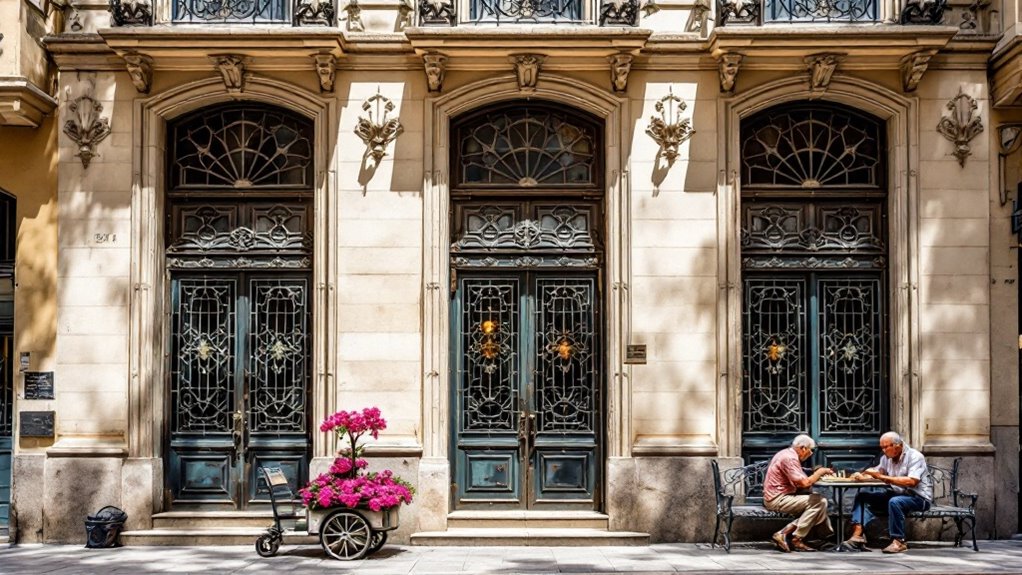
Despite its initial development as an elite enclave in 1867, Santa María La Ribera has evolved into one of Mexico City’s most fascinating cultural districts.
You’ll discover the stunning Kiosko Morisco, a Moorish Revival pavilion that anchors the vibrant Alameda de Santa María park, where locals gather for dance classes and artisan markets.
The neighborhood’s architectural treasures include the haunted Casa de los Mascarones, adorned with mysterious stone masks, and the Byzantine-style Parroquia Josefina church. Recent years have seen an influx of upper-middle-class residents drawn to the area’s historic mansions and affordable real estate prices.
Don’t miss the Mercado La Dalia for authentic tlacoyos, or the century-old Pulquería Xochitl for traditional pulque.
As you wander down Santa María La Ribera Street, you’ll encounter a mix of pastel-colored Porfiriato mansions, street art, and family-run shops that perfectly capture the area’s historic-meets-modern charm.
La Condesa captivates visitors with its crown jewel, the sprawling 22-acre Parque México, built on the former Hipódromo racetrack of the 1920s.
Step into Mexico City’s urban oasis, where a historic racetrack transformed into Parque México’s verdant twenty-two acres of tranquility.
The area’s rich history dates back to when María de la Campa owned vast estates here as the Countess of San Mateo de Valparaíso.
You’ll discover Art Deco monuments, including the Lindbergh Forum with its five monumental pillars and the restored clock tower that plays classical music.
For budget-friendly exploration, stroll along the circular Avenida Ámsterdam, where craft beer bars and international restaurants line the streets.
Don’t miss El Pendulo, a bookstore café featuring live jazz, or the authentic street food vendors serving tlacoyos near the park.
While trendy spots like Condesa DF’s rooftop bar offer panoramic views, you’ll find better value at local haunts like Bar Malverde, known for its lucha libre-themed cocktails.
Visit the parks early morning to avoid crowds and experience the neighborhood’s peaceful side.
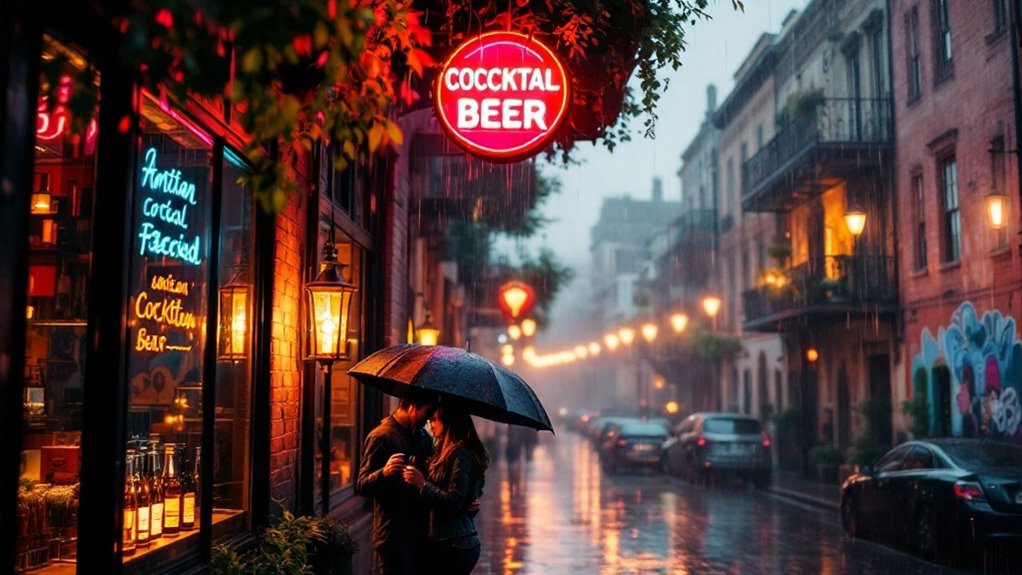
Once a grand enclave of Mexico City’s elite in the early 1900s, Juárez has transformed into the capital’s premier destination for craft cocktails and hidden bars.
You’ll find world-class speakeasies like Handshake, ranked #1 globally, tucked behind unassuming facades, while Hanky Panky lurks behind a fake drinks fridge.
For budget-conscious visitors, the craft beer scene offers better value. Inside popular speakeasies, expect to pay around 250 pesos per cocktail.
Head to The Beer Company Juárez for 30+ taps, or join pub quizzes at Jardin Juarez beer garden.
The neighborhood’s Art Nouveau architecture and leafy streets are best explored during Sunday’s car-free hours on Reforma.
After dark, stick to the safe zone between Amberes and Hamburgo streets, where you can bar-hop between Parker & Lenox’s jazz sessions and Brooklyn Rippers’ retro cocktail den.
While Mexico City’s artistic heritage often conjures images of Rivera’s indoor murals, the city’s contemporary street art scene has exploded into a vibrant outdoor gallery spanning multiple neighborhoods.
These neighborhoods serve as an open-air museum, displaying an ever-changing collection of artistic expression at every turn.
From Roma Norte’s surrealist creatures to Doctores’ skeletal masterpieces, each district offers its own artistic personality.
For the best street art encounters, check out these hotspots:
Most locations are easily accessible by metro and free to explore on foot.
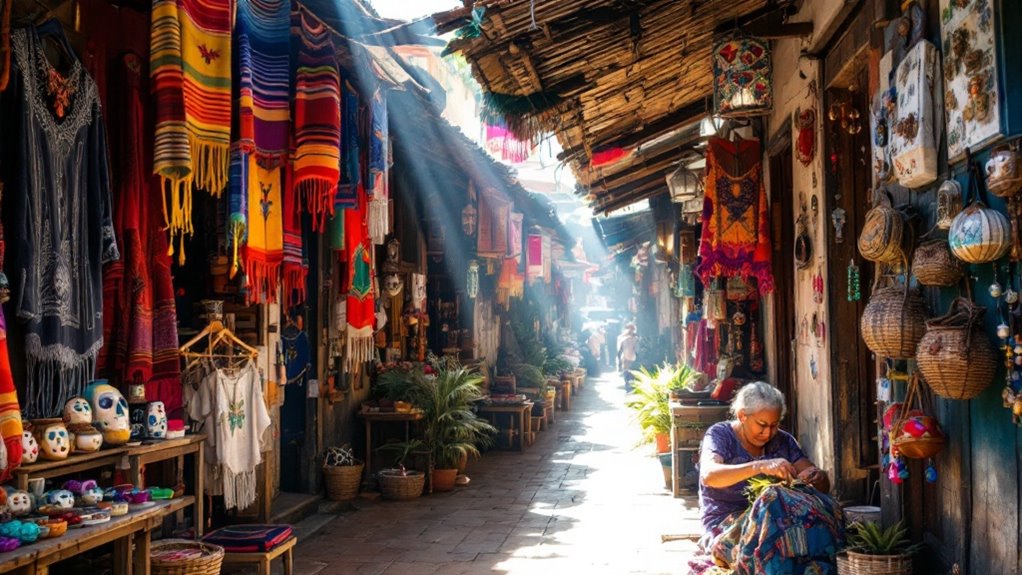
Shopping havens in Mexico City range from sprawling traditional markets to intimate artisan boutiques, each offering unique glimpses into the country’s rich cultural heritage.
From bustling street markets to hidden craft shops, Mexico City’s retail landscape reflects centuries of artistic tradition and cultural diversity.
You’ll discover vibrant handicrafts at La Ciudadela, where local artisans showcase colorful alebrijes and handwoven textiles. For a sensory overload, head to Mercado de Jamaica‘s thousand-plus flower stalls or explore Mercado de Sonora’s mystical aisles of medicinal herbs and ritual supplies.
Roma Norte and Condesa’s slow-fashion boutiques contrast with the traditional offerings at San Ángel’s weekend Bazaar Sábado. The market’s tree-shaded walkways provide a peaceful atmosphere for browsing artisanal goods and enjoying live music.
Don’t miss the Popular Arts Museum shop, representing over 500 artisans nationwide. Remember to bring cash and reusable bags, and time your visits to tianguis markets after 10 AM.
For culinary adventures, Mercado San Juan offers exotic meats and rare chiles.
You’ll find Mexico City’s neighborhoods are like pages from different chapters of history, each with its own groove and story to tell. From Frida’s stomping grounds in Coyoacán to the gramophone-meets-gastropub vibe of Roma Norte, these districts won’t break your bank while serving up centuries of culture. Whether you’re hunting for street art or colonial architecture, these barrios offer authentic experiences at yesterday’s prices.